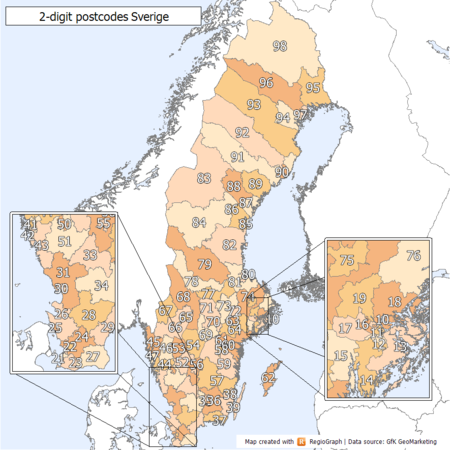Format
The Swedish postcode system is based on a five-digit number combination, divided into two groups of three and two digits. The principle of numbering is that the lower the postcode, the further south the place is located. Excluded from the principle are postcodes beginning with number 1, which represent the capital city, Stockholm. Mail delivery centers are divided into two-, three-, and five-digit positioning groups depending on the size of the geographical place. The two-position group has larger varieties, whereas the smallest belongs to the five-digit positioning group.
According to the system, a space shall be inserted between the third and fourth digit. Earlier recommendations said that a double space should be placed between the postcode and the geographic location and that the geographic location should be written in capital letters. A single space is now the norm and capital letters are not required anymore.
A typical address would look like this:
- Sven Nilsson (First, and last name)
- Roslagsgatan 10 (Street, and number)
- 113 51 Stockholm (Postcode, and geographic location)
Two-digit positioning
The two initial digits indicate city. Stockholm, Gothenburg, and Malmö are designated the two-digit series, one for mailbox- and business addresses, and the second series for street addresses.
The post codes are sorted by geographical location. Numbers starting with 10-19 are part of Stockholm; otherwise, the lower numbers are part of the bigger city areas in the south, and increase northwards.

| Postcode | Geographic location | Notes |
| 10x xx | Stockholm | Mailbox and business addresses |
| 11x xx | Stockholm | Street addresses |
| 20x xx | Malmö | Mailbox- and business addresses |
| 21x xx | Malmö | Street addresses |
| 22x xx | Lund | |
| 25x xx | Helsingborg | |
| 30x xx | Halmstad | |
| 35x xx | Växjö | |
| 39x xx | Kalmar | |
| 40x xx | Gothenburg | Mailbox- and business addresses |
| 41x xx | Gothenburg | Street addresses |
| 50x xx | Borås | |
| 55x xx | Jönköping | |
| 58x xx | Linköping | |
| 60x xx | Norrköping | |
| 63x xx | Eskilstuna | |
| 65x xx | Karlstad | |
| 70x xx | Örebro | |
| 72x xx | Västerås | |
| 75x xx | Uppsala | |
| 80x xx | Gävle | |
| 85x xx | Sundsvall | |
| 90x xx | Umeå | |
| 97x xx | Luleå | Changed from 951 xx |
The third digit in the two-digit positioning indicate type of delivery, in most cases.
| Postcode | Type of delivery | Note |
| xx0 xx | Mail boxes and mail addresses | |
| xx1 xx | Mail boxes and business addresses | |
| xx2 xx | Regular mail delivery | |
| xx3 xx | Regular mail delivery | |
| xx4 xx | Regular mail delivery | |
| xx5 xx | Countryside mail delivery | |
| xx6 xx | Regular mail delivery | |
| xx7 xx | Regular mail delivery | |
| xx8 xx | Regular reply mail | |
| xx9 xx | Temporary | Temporary postcodes |
The fourth and fifth digit indicate the geographic area. Postcodes with the same first four digits may represent a part of a city or equivalent.
Three-digit positioning
The first two digits indicate the geographical area in. Previously, these figures indicated the mail terminal that sorted mail for the particular geographic location.
The third figure in combination with the first two indicates the mail delivery location. The fourth figure is the type of delivery.
| Postcode | Type of delivery |
| xxx 0x | Mailboxes- and postal addresses |
| xxx 1x | Mailboxes, business addresses |
| xxx 2x | Regular mail delivery, mailboxes, and reply mail |
| xxx 3x | Regular mail delivery |
| xxx 4x | Regular mail delivery |
| xxx 5x | Regular mail delivery |
| xxx 6x | Regular mail delivery |
| xxx 7x | Regular mail delivery |
| xxx 8x | Reply mail, and business addresses |
| xxx 9x | Countryside mail delivery |
Five-digit positioning
Five-digit positioning is used for locations small enough that only one or a few postal codes are required for routing. Since the reform of the postcode system in the mid-1990s, only a few five-digit positions locations remain. These locations are often so small and remote that it is not practically possible to transfer all mail to a larger three-digit locations. Five-digit position locations are usually in the archipelago and in the mountains.